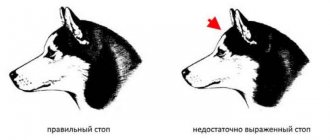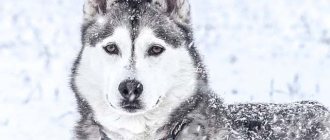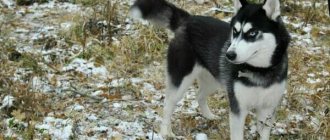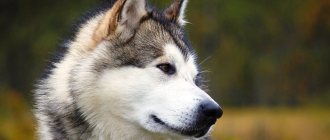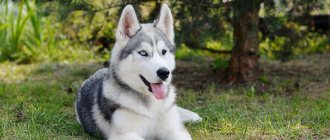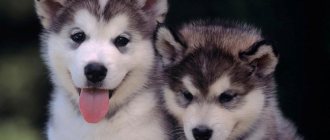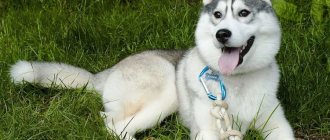To a person who is far from dog breeding, huskies and malamutes look almost like twins: both of these dogs seem equally large and fluffy to him.
But, despite some external similarities, as well as a common original purpose, the husky and malamute have quite a lot of differences.
The difference between these dogs becomes especially noticeable when they are side by side, for example, in the show ring.
And then even a non-specialist becomes clear that these are representatives of two different breeds.
A little about malamutes
Description and what they look like in the photo
The Alaskan Malamute is a fairly large northern sled dog of the aboriginal type, distinguished by a strong physique and well-developed muscles .
Its coat is two-layered, consisting of a soft undercoat and coarse, denser guard hair.
Colors vary from grayish to black, and reddish or sable coat color is also acceptable. At the same time, the Malamute necessarily has the so-called undercolor - lightening to white on the belly, chest, neck, head, hind legs and tail. Of the single-color colors, only white is considered acceptable.
Other characteristics of the appearance of Malamutes:
- The body of Malamutes is only slightly stretched: their body length should exceed the height at the withers by no more than 2 cm.
- The head is wide and quite massive, but at the same time commensurate with the body and paws.
- The limbs are strong and powerful, always parallel and well muscled.
- The tail is not too long, moderately pubescent and usually carried over the back in the form of a plume.
- Malamutes have medium-sized ears, erect, triangular. Set relatively wide and low, which gives the dog's muzzle a good-natured and calm expression.
- The eyes are small, almond-shaped, slightly slanted. Only brown eye color is allowed; blue iris or heterochromia are disqualifying defects.
When evaluating a dog at an exhibition, the proportionality of the build and the productivity of the gait are of greater importance than individual parameters.
Advantages and disadvantages
Pros:
- They are distinguished by strength and endurance.
- Smart and smart.
- Friendly to people.
- Affectionate and obedient.
- Loyal to children.
- They tolerate loneliness quite well: they do not howl when left alone in the house and do not cause damage to the interior.
- Beautiful and stately.
- Can be used as a sled dog or sport dog.
Minuses:
- They show aggression towards small animals.
- They have a tendency to dig up the earth.
- They shed heavily.
- They don't make very good watchmen.
- They need a lot of physical activity.
Character
The Alaskan Malamute is a friendly, loyal and affectionate dog . He treats all family members equally well and willingly looks after the children, patiently enduring all their pranks.
But at the same time, the Malamute does not like to be pestered too much: calm and friendly by nature, it can show dissatisfaction if it is teased or offended.
Outwardly, such a dog looks large and powerful, but due to its innate good nature and the good attitude developed over the centuries towards all people without exception, it is not suitable for the role of guard of a house or apartment..
Malamutes are strong and strong animals that, while usually obedient and friendly, can sometimes be stubborn and self-willed.
These dogs are characterized by intelligence and intelligence, thanks to which they were able to survive in the harsh climatic conditions of Alaska.
WE HAVE MALAMUTES PUPPIES
According to the breed standard, the Malamute is not intended for sled dog racing and was not designed for speed competition.
. The Malamute was bred for strength and endurance, and any trait in an individual, including temperament, which interferes with this goal should be considered a most serious fault.
Both historical and modern literature on the breed describes a clear distinction between the physical traits associated with the Alaskan Malamute as a hauling dog and those of breeds whose development was geared towards speed in the sled, such as the Siberian or Alaskan Husky. The Alaskan Malamute breed standard clearly reflects and supports this distinction.
Alaskan Malamute (female) Ch Nanuke's Still The One (Kimmy)
Siberian Husky (female) Ch Davik's Snowmist Ice Fox
Samoyed (female) Ch. Dorian Spring Ave Maria
| Alaskan Malamute | Siberian Husky | Samoyed | |
| Purpose | Transporting heavy loads at low speed over long distances. | Transportation of light loads over long distances at considerable speed. | Sled dog, companion dog. |
| General form | A powerful, athletically built dog, with a deep chest and well-developed muscles. The Malamute stands firmly on its feet and gives the impression of a very energetic dog with its head held high. | A working dog of medium size, with a fast and light gait, with free and elegant movements. Balance of strength, speed and endurance. A certain reserve of restraint and dignity may be evident in an adult dog. | Medium sized, elegant, white Arctic Spitz. In appearance one can feel power, endurance, charm, softness, dignity and self-confidence. Gender must be clearly expressed. |
| Scull | Wide | Medium width | Wide |
| Facial expression | Soft, friendly, shows affection and affection, lively interest and curiosity are visible in the eyes. | Sharp, sometimes angry, wary, cunning and mischievous, interested. (the author of the definition is Polina Panyukova) | The expression of a teddy bear (for the Finnish line) or a wolf (for the American breeding line) with the so-called “Samoyed smile” due to the combination of the shape of the eyes, their location and the slightly upward-curving corners of the mouth. |
| Bridge of the nose, stop (transition from forehead to muzzle) | Slightly deviating from a straight line | Well expressed | Well expressed |
| Muzzle | Large, voluminous | Conical | Conical |
| Lips | Tightly compressed | Closely squeezed | Rounded, not drooping to the corners |
| Ears | Medium size, small in relation to the head | Medium, thick, well pubescent | Medium, thick, well pubescent |
| Ear fit | Widely spaced on the outside of the skull | Set high, pointed straight up | Wide apart, but within the border of the outer edge of the skull |
| Eyes | Oval, obliquely set, brown. Blue eyes or eyes of different colors are not allowed. | Oval, obliquely set. The eyes may be brown or blue; divergence of eyes and partial coloring are acceptable. | Oval, inclined upward, dark brown in color. Blue eyes or eyes of different colors are not allowed. |
| Nose, pigmentation | Snow nose is acceptable, brown for red dogs, black for all others | Snow nose is acceptable, pink in white dogs, liver in red dogs, black in all others | Black is preferred, but other colors are not penalized. |
| Bite | Scissor-shaped, large teeth | Scissor-shaped | Scissor-shaped, strong teeth |
| Neck | Strong and curved | Medium and curved | Strong, well muscled |
| Ribs | Well developed chest and ribs | Quite elastic, not barrel-shaped | Sufficiently elastic |
| Topline | The back is straight, slightly inclined towards the hips | One level from withers to croup | The withers are the highest, the back is level with the lower back, the loin is slightly arched, the croup is slightly sloping |
| Tail | A swinging “fan” over the back, not grasping and not tightly twisted into a ring. Can be pulled back while moving. | A round panicle above the back (“fox tail”), when moving it is directed upward or curved. with a sickle, in a stance below the level of the back. | Richly covered with long hair, carried over the back or side. In a calm state it can be lowered. |
| Height at withers | Ideal: male - 63.5 cm, female - 58.5 cm, natural deviation is allowed. No extreme growth limits have been established. | Males: 53.5 - 60 cm. Females: 50.5 - 56 cm. Dimensions represent the extreme limits of growth. | The ideal height for males is 57cm ± 3cm and for females - 53cm ± 3cm. |
| Weight | Ideal: male - 38 kg, female - 34 kg, natural deviation is allowed (weight is proportional to height). No extreme limits have been set. Massive bones are welcome, but without excess weight. | Extreme growth limits: males: 20.5 - 28 kg, females: 15.5 - 23 kg. Any manifestations of excessive bonyness or weight are punished. | From 23 to 30 kg. Weight in proportion to height |
| Proportions | slightly stretched (optimal ratio of height at withers to body length 9/10) | stretched | Almost square (body length approximately 5% greater than height at withers) |
| Bones | massive | average | Massive for the size |
| Pasterns/tarsus | Short, strong, slightly sloping | Strong, slightly inclined, flexible | Strong, straight but flexible |
| Paws | Large, snowshoes, compact, thick pads, fur between the toes | Medium size, oval, compact, thick pads, fur between toes | Large, long, almost flat, thick pads, feathering on legs |
| Stifles (back leg angles) | Moderate angulation, slightly flexed, metatarsus straight down | Well defined corners, located close to the ground | Well defined, 30% of the height from the hip |
| Wool | Double, “standing”: (1) dense, oily, woolly undercoat, similar to felt, (2) coarse protective coat (awn), harsher than that of a husky. | Double, soft and dense undercoat, protective coat straight and smoothly lying, never standing. | Double: soft thick undercoat, coarse standing protective coat |
| Color | From light gray to black, can also be sable, red, brown and white. The only solid color is white | The color of the Siberian Husky can be almost any color. All colors are allowed from black and brown to pure white | White, cream or white and biscuit (primary color is white with some biscuit markings). Should not give the impression of being pale brown. |
The Malamute, unlike the Husky, is not intended to participate in speed competitions
.
Malamutes are bred to be strong and tough, so any characteristics of the dog, including temperament, that interfere with the Malamute's primary purpose should be considered extremely serious faults. More information about the Alaskan Malamute breed:
- Alaskan Malamute (introduction to the breed): questions and answers
- Alaskan Malamute breed standard (with illustrations)
- Raising and training a Malamute
Briefly about huskies
Description
The Siberian Husky is a northern sled dog of medium height , fast and agile, in which endurance and running speed are successfully combined with harmony and some grace of physique .
Males of this breed look more courageous: they have stronger bones and better developed muscles. But more feminine and graceful females should also not appear too delicate or weak.
Regardless of gender, the husky has a compact body with well-developed and strong muscles.:
- The head should not be coarse and massive, nor too light. The transition to a moderately wide muzzle is well defined, but not abrupt.
- The ears are medium in size, triangular in shape, erect and set high.
- The eyes are almond-shaped, moderately widely spaced, blue or brown. Heterochromia is also allowed.
- The limbs are moderately wide, straight and parallel, with well-developed muscles.
- The tail resembles a fox's in shape and size. When calm, it is lowered and straightened; when alert, it rises above the back and is carried in the shape of a sickle.
- The coat consists of a soft and warm undercoat, as well as a short, smooth-lying awn.
Huskies can have any color, from white to black , and often have a light mask of a characteristic shape on the head .
Show huskies are somewhat different from working and sporting dogs: they look more impressive, but at the same time, due to their shortened muzzle, they are not so hardy.
Advantages and disadvantages
Pros:
- They are smart and know how to make their own decisions.
- Beautiful and charming: huskies have expressive eyes and rich facial expressions.
- They do not show aggression towards strangers.
- They treat children well.
- They love to follow their owner everywhere.
Minuses:
- Not suitable for protection.
- They love to dig the ground and create tunnels.
- Wouldn't mind hunting birds or, for example, cats.
- They can be stubborn and self-willed.
- Prone to escape.
- Left alone, they often howl out of boredom, chew furniture or tear off wallpaper.
Huskies love to be busy and it doesn’t matter to them whether it’s a show career, sports, or just long walks in the company of their beloved owner.
Character
Huskies are friendly and affectionate, but at the same time somewhat independent . These dogs are vigilant and careful, however, due to their lack of a protective instinct, they are too trusting and make poor watchdogs.
This dog is excellent at adapting to different conditions, he is neat and clean.
Self-sufficient and independent, reminiscent of a cat in character, he has a tendency to run away and walk on his own, and therefore needs careful supervision, especially if he lives in a rural area.
The Husky is best suited for sports and carrying light loads than for any other work.
Malamute and husky: external differences
Huskies are very fast and hardy dogs. They are not too tall. Their height does not exceed 60 cm. A distinctive feature of representatives of this breed is their almond-shaped blue eyes. Much less common are individuals with brown or even multi-colored eyes. These exceptions are not a defect. The husky's nose is black or brown; sometimes there is a so-called “snow nose” with pink veins. The tail is very reminiscent of a fox - fluffy and drooping. The coat is thick, with a black and white, gray-brown or pure white color.
Malamutes are typically much larger than Huskies. Its height exceeds 60 cm. This dog has a powerful, slightly square body and a wide head. The main feature of the Malamute is its eyes. They have a striking black outline. In addition, the nose and lips must be black. The Malamute has a black “mask” on its face. The tail is usually carried up, but not too curled. The eyes of this powerful dog are brown. The animal's fur is colored gray and black.
What are the differences?
Malamutes are large and broad-boned, they look more massive than the fit and lighter Huskies.
The height at the withers of a husky is 52-55 cm at the withers with a weight of 20-30 kg, while for a malamute it is 60-65 cm with a body weight of 32-43 kg.
The Malamute's head is noticeably larger, more massive and wider.
Its ears are slightly rounded at the ends and set wide apart, whereas the Husky's ears are pointed and set quite close.
The Malamute's eyes are almond-shaped, with a friendly and calm expression . Husky eyes are medium in size, with slightly raised corners, and their gaze is attentive, and sometimes even stern.
NOTE!
If in a husky both blue and dark eyes and even heterochromia are considered acceptable, then in a malamute the eyes should only be brown.
The Malamute's nose is larger in size and usually black. A husky's nose is smaller and may have darker pigmentation on the sides than in the center.
The Malamute's tail is carried at the level of the back and looks like a plume . A husky's tail hangs down when at rest and only when it is interested it rises above its back in the shape of a sickle.
In addition, the Malamute has strong and powerful paws, while the Husky looks taller and its paws are not too large in size.
The color of the Malamute is most often black or grayish, although it can be red, sable with undergrowth, and pure white. A husky's coat color can be any color.
The Malamute's coat is longer, but coarser, while the Husky's is shorter, softer and smoother..
By nature, the Malamute is calm and balanced, while the Husky is temperamental, cunning and stubborn. And, if strength and power are felt in the movements of the Malamute, then the gait of the Husky is fast and energetic.
Huskies have a habit of howling, while Malamutes do this extremely rarely..
What is the difference between a husky and a malamute?
- Malamutes from Alaska are broad-boned in appearance and look more massive, larger than the light, fit Siberian Huskies.
- Huskies have attentive eyes, often with a stern look, while Malamutes have a calm and friendly look.
- Malamutes are calmer in character and much more loyal to their owner.
- Another interesting difference between them is that they have a very shaggy tail, which they hold around their muzzle, which helps protect their nostrils from snow.
- Huskies have a soft outer coat, while Malamutes have a rough, two-layer coat with an undercoat.
- The Malamute's tail is worn at the level of the back, while the Husky's tail is often lowered, only when alert, raised like a sickle over the back.
Alaskan Malamute - description of the breed
A large breed with well-developed muscles. The color can be white or with shades of gray and black. Interestingly, there is always lightening in the chest, abdomen, head, neck, and tail. The almond-shaped eyes are exclusively brown in color.
Siberian Husky description
The breed is of medium height with a compact body and well-developed muscles. The tail looks like a fox's. They come in any color, including white and black. It is distinguished by a characteristic light mask on its head. The eyes are blue, but can also be brown, with a very expressive look, they even have rich facial expressions.
For what purposes are they intended?
- Malamutes are adapted for transporting heavy loads over short distances. Breeding location: Alaska.
- Husky - for transporting small loads over long distances at great speed in Siberia.
An excellent comparison comes to mind: Huskies rush like “fast cavalry”, and Malamutes move like “heavy artillery”.
Character traits
Malamute. Quite a reserved dog, balanced. He will never be the first to disturb the owner, pester him, and at the same time does not hide his delight and pleasure from communication. We train well. In relation to other dogs he is dominant, towards strangers he is calm as long as he is not disturbed. They tolerate loneliness well; they do not howl when left in the house.
Husky. Playful by nature, energetic, cunning, affectionate, loves kids. Very “clingy” to his owner. Suitable for mobile, active people. It has disadvantages: wayward ambition, if it doesn’t work up, it can run away. Sheds a lot. They cannot stand loneliness, they chew furniture and wallpaper, and howl from boredom.
Are they suitable for protection?
Husky is unlikely to make a good watchdog, because dogs are kind, and they treat everyone indiscriminately.
Malamutes are completely non-aggressive dogs and practically do not bark. Instead of barking, they can produce sounds of a kind of “grumbling”, inherited from distant “relatives” - wild wolves.
| Alaskan Malamute | Siberian Husky | Samoyed | |
| Purpose | Transporting heavy loads at low speed over long distances. | Transportation of light loads over long distances at considerable speed. | Sled dog, companion dog. |
| General form | A powerful, athletically built dog, with a deep chest and well-developed muscles. The Malamute stands firmly on its feet and gives the impression of a very energetic dog with its head held high. | A working dog of medium size, with a fast and light gait, with free and elegant movements. Balance of strength, speed and endurance. A certain reserve of restraint and dignity may be evident in an adult dog. | Medium sized, elegant, white Arctic Spitz. In appearance one can feel power, endurance, charm, softness, dignity and self-confidence. Gender must be clearly expressed. |
| Scull | Wide | Medium width | Wide |
| Facial expression | Soft, friendly, shows affection and affection, lively interest and curiosity are visible in the eyes. | Sharp, sometimes angry, wary, cunning and mischievous, interested. (the author of the definition is Polina Panyukova) | The expression of a teddy bear (for the Finnish line) or a wolf (for the American breeding line) with the so-called “Samoyed smile” due to the combination of the shape of the eyes, their location and the slightly upward-curving corners of the mouth. |
| Bridge of the nose, stop (transition from forehead to muzzle) | Slightly deviating from a straight line | Well expressed | Well expressed |
| Muzzle | Large, voluminous | Conical | Conical |
| Lips | Tightly compressed | Closely squeezed | Rounded, not drooping to the corners |
| Ears | Medium size, small in relation to the head | Medium, thick, well pubescent | Medium, thick, well pubescent |
| Ear fit | Widely spaced on the outside of the skull | Set high, pointed straight up | Wide apart, but within the border of the outer edge of the skull |
| Eyes | Oval, obliquely set, brown. Blue eyes or eyes of different colors are not allowed. | Oval, obliquely set. The eyes may be brown or blue; divergence of eyes and partial coloring are acceptable. | Oval, inclined upward, dark brown in color. Blue eyes or eyes of different colors are not allowed. |
| Nose, pigmentation | Snow nose is acceptable, brown for red dogs, black for all others | Snow nose is acceptable, pink in white dogs, liver in red dogs, black in all others | Black is preferred, but other colors are not penalized. |
| Bite | Scissor-shaped, large teeth | Scissor-shaped | Scissor-shaped, strong teeth |
| Neck | Strong and curved | Medium and curved | Strong, well muscled |
| Ribs | Well developed chest and ribs | Quite elastic, not barrel-shaped | Sufficiently elastic |
| Topline | The back is straight, slightly inclined towards the hips | One level from withers to croup | The withers are the highest, the back is level with the lower back, the loin is slightly arched, the croup is slightly sloping |
| Tail | A swinging “fan” over the back, not grasping and not tightly twisted into a ring. Can be pulled back while moving. | A round panicle above the back (“fox tail”), when moving it is directed upward or curved. with a sickle, in a stance below the level of the back. | Richly covered with long hair, carried over the back or side. In a calm state it can be lowered. |
| Height at withers | Ideal: male – 63.5 cm, female – 58.5 cm, natural deviation is allowed. No extreme growth limits have been established. | Males: 53.5 – 60 cm. Females: 50.5 – 56 cm. Dimensions represent the extreme limits of growth. | The ideal height for males is 57 cm ± 3 cm and for females – 53 cm ± 3 cm. |
| Weight | Ideal: male – 38 kg, female – 34 kg, natural deviation is allowed (weight is proportional to height). No extreme limits have been set. Massive bones are welcome, but without excess weight. | Extreme growth limits - males: 20.5 - 28 kg, females: 15.5 - 23 kg. Any manifestations of excessive bonyness or weight are punished. | From 23 to 30 kg. Weight in proportion to height |
| Proportions | slightly stretched (optimal ratio of height at withers to body length is 9/10) | stretched | Almost square (body length approximately 5% greater than height at withers) |
| Bones | massive | average | Massive for the size |
| Pasterns/tarsus | Short, strong, slightly sloping | Strong, slightly inclined, flexible | Strong, straight but flexible |
| Paws | Large, snowshoes, compact, thick pads, fur between the toes | Medium size, oval, compact, thick pads, fur between toes | Large, long, almost flat, thick pads, feathering on legs |
| Stifles (back leg angles) | Moderate angulation, slightly flexed, metatarsus straight down | Well defined corners, located close to the ground | Well defined, 30% of the height from the hip |
| Wool | Double, “standing”: (1) dense, oily, woolly undercoat, similar to felt, (2) coarse protective coat (awn), harsher than that of a husky. | Double, soft and dense undercoat, protective coat straight and smoothly lying, never standing. | Double: soft thick undercoat, coarse standing protective coat |
| Color | From light gray to black, can also be sable, red, brown and white. The only solid color is white | The color of the Siberian Husky can be almost any color. All colors are allowed from black and brown to pure white | White, cream or white and biscuit (primary color is white with some biscuit markings). Should not give the impression of being pale brown. |
You may also be interested in: What are the similarities and differences between humans and animals?
How are the breeds similar?
- Both are considered quite hardy and frost-resistant, as they were bred in a difficult climate in the treacherous northern conditions.
- These dogs are the most reliable companions. They lack causeless aggression by nature. There have been isolated cases in practice due to the fault of the person himself.
- Both breeds are endowed with the highest intelligence, are easy to train, and get along well with kids. In different situations they are able to make decisions independently.
- They are friendly towards other animals; general hostility is expressed only towards cats.
- Coat care requires special attention, periodically brushing, and during the shedding season this should be done daily.
- They are endowed with an instinct for hunting, as they are considered a hunting breed.
- At the same time, they love affection and wait for it.
- Must receive daily exercise: 1-2 hours a day, 3 times the most active walks. Otherwise, energy will accumulate and flow out in an undesirable way.
How long do they live?
Smaller Huskies live for about 12-14 years, and slightly larger Malamutes live up to 15 years.
Haskomut or Aluskys cross
If you cross both breeds with each other, you get the most wonderful creation - Haskomut or Aluskys. The dog is ideal if the breeder does not have the goal of visiting various exhibitions. The mixed breed will combine the best character traits of its parents: the phlegmatic Malamute will be diluted by the tireless husky. The crossed dog will be an ideal friend for a family with children. Professional racers use this breed most often.
How are they similar?
Both dogs were bred in the North, and therefore both Huskies and Malamutes are perfectly adapted to harsh climatic conditions and are particularly resilient and frost-resistant.
Over centuries of close interaction with people, representatives of both breeds have learned to trust unconditionally and have a habit of becoming strongly attached to their owners..
Both of these dogs are smart and can make their own decisions when necessary.
They both have triangular erect ears, a long fluffy tail and a two-layer coat, which is most often grayish or reddish-brown, which is mainly due to the external similarity of these breeds.
Both Malamutes and Huskies were bred as sled dogs, but if the duty of the former was to transport heavy loads, then Huskies were valued for their speed in delivering goods..
Distinctive features
Here is a comparison of the physical abilities and temperament of the Husky Malamute breeds:
- Hunting skills. Both dogs know how to hunt and are distinguished by their keen eyesight, good scent and endurance.
They are naturally able to find their own food on their own in the wild forest. However, they will not give their prey to a person, and they will not bring back a shot animal. - Ride quality. Huskies and Malamutes are bred specifically for sled riding. Compared to its brother, the Malamute can pull heavier loads over longer distances. His running speed is not high, unlike a fast husky that can carry a small load quite quickly. Huskies are lighter dogs that often take part in speed competitions.
- Character. Malamutes and huskies behave completely differently. The former are distinguished by a calmer character and friendly attitude. The latter, on the contrary, are cunning, curious and temperamental. Husky will find a common language with children. These dogs love to play and never show unmotivated aggression towards both humans and other animals. Malamutes will not take care of babies and babysit them, but they will become a loyal friend to their owner.
Huskies are very vocal and loud dogs, while Malamutes, on the contrary, are silent, they almost never bark.
Which breed is best suited for living in an apartment?
The Malamute has a calmer disposition and does not tend to misbehave when left alone all day.
Huskies can also be kept in the city, but it must be taken into account that these dogs are prone to mischief out of boredom and if the owner does not want to return home to find chewed furniture or wallpaper torn from the walls, he should take care of purchasing a cage for the pet.
Huskies often howl when left alone, and therefore the owner will have to make a lot of effort to wean them from this bad habit..
Expert opinion
Kozhevin Semyon Kirillovich
Expert dog handler.
“Malamute and husky may seem the same only at first glance. Despite the fact that both of these dogs are northern sled breeds, they have much more differences than similarities. Malamutes are calmer and even phlegmatic, while huskies are emotional and very active. It is impossible to immediately say which of them is better and which one should be started. The future owner, when choosing a pet breed, must decide who is more suitable for him in temperament and character: a calm malamute or a temperamental husky.”
Who is easier to maintain and care for?
Both Huskies and Malamutes require occasional brushing and infrequent bathing. They will also need to have their eyes and ears cleaned from time to time, and their nails trimmed if necessary.
It should be taken into account that representatives of both breeds shed heavily, and therefore during the shedding season the pet will have to be combed not a couple of times a week, as usual, but daily.
Character and facial expression
Probably the biggest difference between a husky and a malamute lies in their characters. In appearance, many people think that the Malamute is an aggressive dog. But this is an erroneous judgment. Breeding standards prevent this. Realizing that the wild wolf mixture in such a huge dog was dangerous, breeders fought with the Malamute's genetics, trying to remove the aggressive predator gene.
The peculiarity of the dog is the absence of barking as such - this is a wolf heritage. Against its peaceful background, the husky looks completely different. This is an irrepressible dog that is interested in everything that happens around it, it has its own opinion on any matter. That is why, from an early age, you need to pay special attention to training, otherwise you will end up with an indomitable destroyer who does not recognize anyone’s authority. The Malamute's facial expression is soft and friendly, maybe de
Attitude towards children and pets
Huskies have an active and playful disposition; they are better suited for playing with older children. Malamutes treat children quite well, but rather in a protective manner than in a friendly manner.
As for the attitude towards other pets, the Malamute, being a natural leader, strives to dominate other dogs.
In addition, he may not be too kind to cats, rodents and other smaller pets.
However, a husky, due to its hunting instincts, may try to hunt other domestic animals or birds.
Whichever of these two breeds the dog is, in any case it needs early socialization and proper upbringing.
Comparison by other criteria
Life expectancy and health
The life expectancy of Huskies is, on average, 12-14 years, and for Malamutes it reaches 13-15 years.
Both breeds enjoy good health, but may be susceptible to eye problems, musculoskeletal disorders, and diabetes..
Huskies that participate in sports may also develop respiratory problems.
Due to the fact that Malamutes and Huskies have such a good appetite and are always ready to eat at any opportunity, they are susceptible to obesity and related diseases.
Aggressiveness towards strangers
Neither malamutes nor huskies have it naturally.
Obedience
The Malamute is more obedient and less likely to be stubborn and willful than the Husky..
On the other hand, he needs a strong and self-confident owner, since otherwise he simply will not be able to prove to the dog his physical and moral superiority.
Which breed should you choose?
Huskies can be recommended as a pet to active people involved in sports or to families with older children: such a dog will become a good companion while jogging, as well as an excellent playmate.
If the future owner does not like noise and fuss, then it is better for him to choose a calmer and more balanced Malamute.
When choosing between representatives of these two breeds, you need to remember that both huskies and malamutes are sled dogs that require a lot of physical activity.

